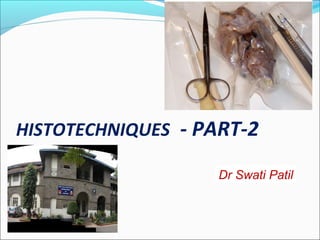
7 histo seminar copy
- 1. HISTOTECHNIQUES - PART-2 Dr Swati Patil
- 2. INTRODUCTION • Histological technique deals with preparation of tissue for microscopic examination. Total or a selected part undergoes series of processes, namely, - Fixation - Dehydration - Clearing - Embedding - Cutting - Staining
- 3. DECALCIFICATION • Tissue : bones & teeth • Criteria for decalcifying agent: - Complete removal of Ca salts - No damage to tissue - Lack of harmful effect on staining reactions - Speed for removal of Ca salts
- 4. METHODS OF DECALCIFICATION • Chemical method -Acid reagents -Nitric acid -Trichloracetic acid -Formic acid -Chelating agents: - Ethylene Diamine Tetra acetic acid[EDTA] • Ion–exchange resin method ( ammonium form of sulphonated polysterene resin) • Electrophoretic method
- 5. DEHYDRATION Definition: Alcohols of different strengths Mechanism of action: Time required for dehydration: Volume of dehydrating agent:
- 7. DEHYDRATING FLUIDS • Ethanol: • Industrial methylated spirit: (denatured alcohol) ethanol +1% methanol • Methanol: • Propanol: • Acetone:
- 8. ANHYDROUS CuSO4: Indicator of dehydration Changes into blue colour
- 10. Criteria for suitable clearing agents: -Speedy removal of dehydrating agents. -Ease of removal of molten paraffin wax. -Minimum tissue damage. -Flammability -Toxicity -Cost
- 11. Clearing agents suitable for general use: -Xylene: -widely used -rapid in action -cheap, inflammable -shrinkage & overhardening - block 3-5mm : 15 – 30 mins - Benzene: -cheap, inflammable -vapors show toxicity -no shrinkage & overhardening -Toluene:
- 12. -Chloroform: - expensive -high specific gravity, non inflammable – phosgene gas -slower in action, less transparency - little hardening - Cedar-wood oil: -thin fluid, expensive -used to clear both the paraffin & celloidin sections -penetration is well, improves section cutting -slow in action & less damaging to tissue -emersion in xylene necessary prior to paraffin impregnation
- 13. IMPREGNATION Definition: -placement of tissues with medium - that fill natural cavities, spaces, replaces clearing agent -supports tissue -firmness to tissue -without any injurious effects
- 14. EMBEDDING Done by - Filling mould of suitable size with molten paraffin wax. - Orienting specimen in mould to ensure its being cut in right plane. - Cooling mass to promote solidification
- 15. Types of embedding medium: -Ribboning media: eg. paraffin, soap -Non-ribboning media: eg. sugar, gum solution, gelatin Embedding media: -Water soluble media:- eg. gelatin, gum -Water insoluble media:- eg. Paraffin wax, nitrocellulose
- 16. METHODS OF EMBEDDING • Fusion embedding method:- eg. Paraffin embedding: -simpler, better for routine use -allows thin section to be cut -about 10% shrinkage of section on cooling • Evaporation embedding method : eg. Celloidin embedding - suitable for specimens containing large cavities -slow, tedious, no serial sections -less shrinkage & distortion -no heat & heavy microtome Volume of impregnating medium: at least 25 times of the volume of tissue.
- 17. PARAFFIN WAX • Saturated hydrocarbons, very stable • Water insoluble, burns with smoky flame • Melting pt- 35-65 C • Strongly hydrophobic • Plastic point of paraffin wax • Low melting pt – thick sections • High melting pt – thin sections Wax additives – hardness eg beeswax, rubber, ceresin etc
- 18. Other waxes: -Bees wax -Candle wax -Ester wax -Carbowax Advantages of carbowax -soluble & miscible with water -lipids & natural fats -enzyme histochemistry - thinner sections
- 19. PARAFFIN EMBEDDING Advantages -Reasonable speed of processing -Good consistency for serial sectioning -A wide range of section thickness & durability of block
- 20. STEPS IN PARAFFIN EMBEDDING Selection of proper size of L shaped moulds smeared with glycerol Filling with paraffin wax Selection of tissue Orientation of tissue Insertion of label Cooling of block
- 21. L MOULDS
- 24. Automatic Tissue Processing AUTOMATED TISSUE PROCESSING Principle : Time required for tissue processing may be considerably reduced when tissue is suspended in fluid, continuously agitated, moved from one reagent to another whenever desired, not restricted by working hours. Processors are configured with preset interval for different schedules of suspension, agitation, & automatic changeover
- 25. Advantages: - Reduce time taken for processing - Superior results are obtained - Multiple blocks can be processed together - Less laborious
- 26. MICROTOMES To cut small Cutting engines 3 main srtuctures -block holder -knife carrier -rachet device
- 27. TYPES OF MICROTOME Cambridge rocking microtome Rotary microtome Rotary microtome Sliding & base sledge microtome Freezing microtome Sledge microtome
- 28. TYPES OF MICROTOME Freezing microtome Ultramicrotome Freezing microtome Cryomicrotome
- 29. MICROTOME KNIVES Made up of steel Parts – blade -knife carrier -handle if knife -bevel
- 30. Bevel angle: Breadth of knife: - Bevel angle less, breadth will be large - Bevel angle is more, narrow bevel
- 31. MICROTOME KNIVES Obliquity of knife: angle of knife edge & edge of tissue block Angle of tilt: angle, plane passing through back edge of knife with plane of section
- 32. MICROTOME KNIVES Profile • Profile A: biconcave • Profile B: planoconcave • Profile C: wedge shaped - Wide application • Profile D: chisel shaped
- 33. CARE OF MICROTOMES Cover properly Avoid rust Application of light oil Removing of wax Cleaning of metallic parts
- 34. CARE OF MICROTOMES KNIVES Sharpening of microtome: manual sharpening -Removal of gross nicks -Honing – removal of fine HONING nicks -motion always be from heel to toe -Stropping – sharpen knife which is free of nicks -on leather strop -reverse motion of honing STROPPING
- 35. SECTIONING Insert block into microtome chuck Blade should be angled Discard paraffin ribbon Well ribboning block, pick with fine brush, float them on surface of water bath Float sections onto glass slides
- 37. SECTIONING No ribboning – place block on ice cubes Place slides with parffin sections in 65 c oven for 20 mins Slides stored overnight at RT
- 38. Ready to stain
- 39. THANK YOU
